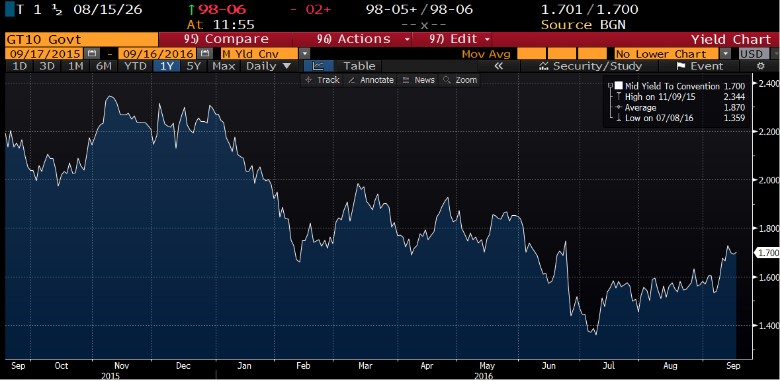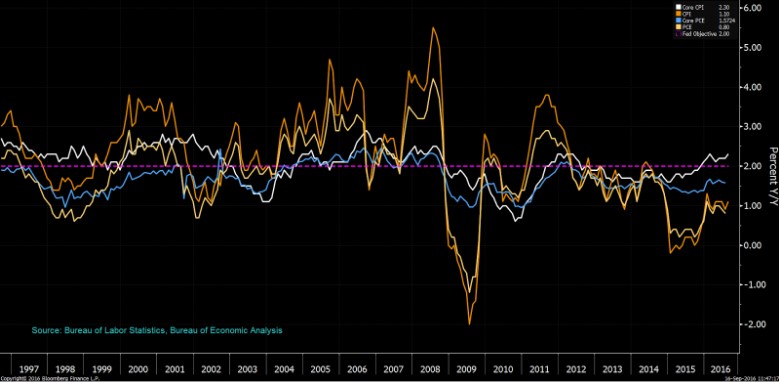Volatility back in play with higher rates and equities wavering
Volatility is on the rise in recent weeks. Equities have started to experience larger moves both up and down. I expect this to continue with the trend to move down as markets start to focus more on the presidential election.
Rates have been on a slow grind higher the last several weeks as the current trend is higher (See the chart on the 10 year Treasury Note below). The jury is still out on where rates will be post-election. I am thinking lower, but that will depend on the data.
This week's Freddie Mac survey reports average mortgage rates climbed to a new high since Brexit, the unexpected development in Great Britain this summer that sent investors scurrying into US Treasurys and mortgage rates into refinance territory.
Still, these average rates in historical context are incredibly low and are helping buyers lock in affordable credit terms.

The latest data
This week, everyone weighed two important economic readings that move markets: Inflation and Retail Sales. Like everything else lately, these reports gave us a mixed bag.
Let's start with inflation. The Producer Price Index, released on Thursday, showed just a 0.1 percent increase in wholesale prices. This is the reading on inflation of goods sold at wholesale. On Friday morning, the Consumer Price Index came in higher than expected at 0.2 percent, or 0.25 percent if you take out volatile energy and food prices.
This is an important number to watch because it tells us if the price of goods we all buy at Walmart, department stores and Amazon are rising. It's not rapid, and most of the increase is caused by more expensive medical prices, but the slight uptick in the consumer price index could be a signal that prices are creeping up after months (even years) of slow economic growth and near-zero inflation.
For interest rates, that's important. The Federal Reserve has two mandates: Encourage full employment and guard against too much inflation. The Fed's target is to keep inflation at about 2 percent annually. The year over year increased 2.3 percent from August 2015 after rising 2.2 percent from the prior year (see chart below).

As inflation rises, you'll see pressure increase on the Fed to raise interest rates. There's still a low probability rates will change this month, but it's something to keep watching.
Retail sales
The other number everyone is talking about is retail sales. Retail sales declined 0.3 percent in August. Analysts attribute most of that to lower fuel prices at gas stations. However, retail sales still fell 0.1 percent in August (a big month for back-to-school retail sales) even after gas stations and auto sales are removed.
Why the drop in retail sales? Most retail categories, other than food stores, saw a decline in sales in August. Leading the way, sporting goods store sales dropped 1.4 percent and furniture stores dropped 0.7 percent. This shows some consumers were pinching pennies as the summer came to a close.
Focus on Fed
Now, everyone's focus turns to the Federal Reserve, which meets in the week ahead to discuss interest rates. Goldman Sachs is predicting just a 25 percent chance Fed Chair Janet Yellen will announce a rate hike on Wednesday. But two speeches by Fed officials sent mixed messages this week, leaving investors searching for clues.
On Monday, Atlanta Fed President Dennis Lockhart, seen as a bellwether on rates by many, said it was time for a "serious discussion" about raising interest rates. He also announced the next day that he will be stepping down in February.
Meanwhile, Fed Governor Lael Brainard, seen by many as a potential Treasury Secretary if Hillary Clinton becomes the next president, on Monday said in a speech that the Fed should consider low rates as an ongoing policy to encourage growth, especially since inflation has remained so low.
"The case to tighten policy preemptively is less compelling" in an environment where declining unemployment has been slow to spur faster inflation, Brainard said Monday, according to Bloomberg.
What happens next? We all watch the Fed's decision on Wednesday and then all focus will be on the election.


